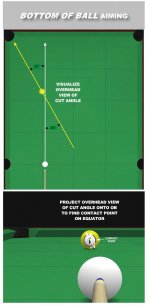Actually PJ illustrated the Ghost Ball principal perfectly....
You just exposed the flaw in the ghost ball method... You don't aim at the ghostball at the geometric contact...
You have to adjust your ghostball for CIT and SIT for it to work....
Most good players know this but you would be surprised by the number of sources out there that explain the system exactly as PJ diagrammed it without any caveats.....
What is the geometric contact.....? It would be nice to have a complete thought here.
Of course you need to adjust, when needed, for CIT and SIT. These do not happen on every shot.
When you move beyond just hoping the ball goes in the pocket to putting it where you want, where the the end point for for the OB direction of travel determines where to put the CB on the spot on the table that makes the OB go where you want when there is no concern for CIT and SIT.
This spot is the starting point on which way and how much you need to adjust based on how you feel the stroke you are going to use is gonna affect the direction of travel of the OB.
There is no flaw in ghost ball only flawed application. There is not a shot that ghost ball can not be used on. Something that can not be said about other methods.
Also, PJ version of ghost ball is just one way to use it. Move the lines down on the table and not hang there in middle air and call them direction of travel lines. Where the OB direction of travel line and the CB direction of travel line intersect is where the CB needs to be to make the OB go where you want.
Again, this is based on Babe Cranfield's arrow. He also states that there are just three lines, OB to pocket, CB to aim point and cue stick to CB.
I'll follow the advice and methods of a member of the Hall of Fame, although unofficial , but not disputed, a higher straight pool run than Mosconi on a 41/2 x 9, over 700. He is a overlooked as one of the greats in the pool world.
